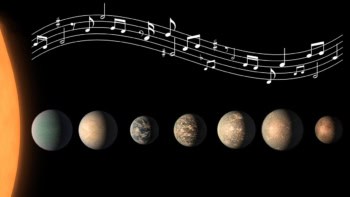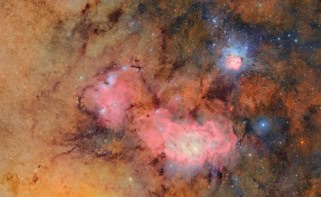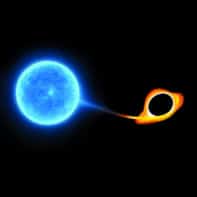With ever-improving telescopes we are peering deeper and deeper into the heavens and witnessing some truly astonishing skyscapes. But these days, spectacular astronomical views are no longer restricted to those with professional telescopes. Anyone with access to a decent camera and dark skies can point their lens skywards and capture some beautiful results

In the latest Physics World photo challenge, we asked readers to submit astrophotography photos to our Flickr group. Thank you to everybody who took part and here is a selection of the images we received.
No astrophotography collection would be complete without the inclusion of some star-trail images. These photos show stars appearing to move in circles, as the Earth rotates relative to the night sky. By keeping their cameras in fixed positions and using long exposures, photographers can trace out these “false” movements to produce creative results.
This first star-trail photo was submitted by Jeff Nyveen. It shows the southern sky at Bea Creek camp in Western Australia, looming dramatically over silhouetted trees. Nyveen says that he used a 4 hr night-time exposure, “set the camera up, clicked the button and went to bed”. No doubt, he woke up to a rather pleasant surprise.
Equally mystical is this second star trail captured by photographer Phil McGrew in the Alabama Hills in the US. McGrew says that he created the image from a combination of 2 min exposures shot during a night when the Moon was at a particularly bright 90%.
 John Pugh has demonstrated that you don’t always need a billion-dollar instrument on the top of a mountain to snap a stunning image of the cosmos. Pugh took this beautiful photo of the Orion nebula from a back garden in Glasgow using a five-inch refractor telescope.
John Pugh has demonstrated that you don’t always need a billion-dollar instrument on the top of a mountain to snap a stunning image of the cosmos. Pugh took this beautiful photo of the Orion nebula from a back garden in Glasgow using a five-inch refractor telescope.
The juxtaposition of this isolated stone house set against a sky glittered with stars, brings a dramatic reminder of our humble location in the cosmos. It was taken by photographer Andy Leung during a night spent alongside Lake Tekapo in New Zealand.
It is amazing what amateur astronomers can see using consumer gear. David Hosking used a modified webcam connected to a Newtonian reflector telescope to snap this image of Saturn with its iconic rings clearly visible.
Hosking used the same telescope to capture this stunning image of the lunar surface, and given the Moon’s significantly closer proximity to Earth you can make out the geology in sharp detail. You can see that the Moon’s face is pockmarked with craters because the lack of water, atmosphere and plate tectonics allows for little erosion to take place.
The Moon has been the inspiration for countless works of art and literature. And the Earth’s natural satellite takes on a particularly magical quality during a supermoon – when a full moon or a new moon coincides with the closest approach the Moon makes to the Earth on its elliptical orbit. This supermoon was photographed from Australia by the Flickr user suzannephotographer, and you can make out the darker basaltic plains of the Moon’s surface known as lunar maria.
In this final Moon shot you can see the bright orange “ring of fire” surrounding the Moon as it passes in front of the Sun relative to our view on Earth. The photo was taken in New Mexico in the US by Nancy Ambrosiano.
The inspiration for this photo challenge was the fact that on 5 and 6 June sky watchers around the world were treated to an astronomical event that they will almost certainly not live to see again. During the transit of Venus our neighbouring planet cut across the face of the Sun as viewed from the Earth, casting a silhouette against the solar surface. Assuming that Newtonian mechanics does not fail us, this planetary shadow play will not occur again until December 2117. Fortunately, there are some great photographers out there who managed to bag this shot-of-a-lifetime.
This lovely image has all the qualities of a watercolour painting. It was submitted by Phil Hart and shows the transit during the sunrise over Leipzig in Germany.
A alternative view of the transit is offered up in this clever image produced by ZongYe Quek in Seoul, South Korea. By combining a series of taken between 11 and 12 o’ clock local time, Quek has managed to trace out the path taken by Venus as it travelled across the Sun’s face from north to south. You can also learn about the transit of Venus and its significance in this video and this feature.
The science of the cosmos is not just about analysing images. It’s also about designing ingenious experiments to develop an understanding from Earth of what is going on out there in space. One of these is Victor Hess’s famous balloon experiments that led to the discovery of cosmic rays in 1912. To mark this 100-year anniversary, several groups are re-enacting the scientific balloon experiments, including this mission know as VHANESSA that launched earlier this year from Lombardy in Italy. The image was supplied by the head of the VHANESSA mission, Marco Arcani.
Thank you to everyone who submitted images and you can see all the images in our Flickr group, Physics World photo challenge.
The theme for our next photo challenge is “the physics and technology of sport”. As always with these challenges we want you to be creative with the theme. But if you are looking for a steer then you might consider trying to get some interesting shots of sports equipment in action. For example, you might aim for images that juxtapose the exertions of athletes with the stress and strains exerted on sporting equipment – rowers cutting through water with their oars, or golfers looking for that perfect swing. Or you might try to explore ways of visualizing the human body as a type of machine that athletes try to optimize for sport. For example, the long lean physique of distance runners, which contrasts with the more muscular powerful body typical of sprinters.
To take part please submit photos to our Flickr group by Monday 6 August, after which we will choose a selection of our favourite images to be showcased on physicsworld.com.













